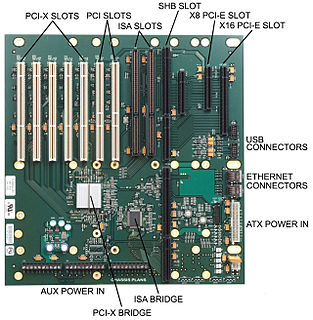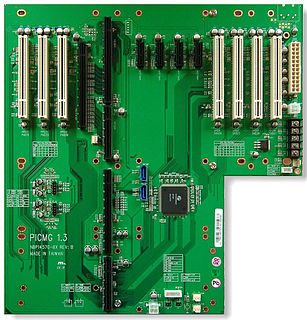
System Host Board is a term applied to a single-board computer meeting the PICMG 1.3 specification. PICMG 1.3 extended the previous PICMG specifications to continue support for PCI/PCI-X expansion cards as well as new support for PCI Express. [1]

System Host Board is a term applied to a single-board computer meeting the PICMG 1.3 specification. PICMG 1.3 extended the previous PICMG specifications to continue support for PCI/PCI-X expansion cards as well as new support for PCI Express. [1]

A backplane is a group of electrical connectors in parallel with each other, so that each pin of each connector is linked to the same relative pin of all the other connectors, forming a computer bus. It is used as a backbone to connect several printed circuit boards together to make up a complete computer system. Backplanes commonly use a printed circuit board, but wire-wrapped backplanes have also been used in minicomputers and high-reliability applications.

Eurocard is a European standard format for printed circuit board (PCB) cards that can be plugged together into a standard chassis which, in turn, can be mounted in a 19-inch rack. The chassis consists of a series of slotted card guides on the top and bottom, into which the cards are slid so they stand on end, like books on a shelf. At the spine of each card is one or more connectors which plug into mating connectors on a backplane that closes the rear of the chassis.

PCI Express, officially abbreviated as PCIe or PCI-e, is a high-speed serial computer expansion bus standard, designed to replace the older PCI, PCI-X and AGP bus standards. It is the common motherboard interface for personal computers' graphics cards, hard disk drive host adapters, SSDs, Wi-Fi and Ethernet hardware connections. PCIe has numerous improvements over the older standards, including higher maximum system bus throughput, lower I/O pin count and smaller physical footprint, better performance scaling for bus devices, a more detailed error detection and reporting mechanism, and native hot-swap functionality. More recent revisions of the PCIe standard provide hardware support for I/O virtualization.

CompactPCI is a computer bus interconnect for industrial computers, combining a Eurocard-type connector and PCI signaling and protocols. Boards are standardized to 3U or 6U sizes, and are typically interconnected via a passive backplane. The connector pin assignments are standardized by the PICMG US and PICMG Europe organizations. The connectors and the electrical rules allow for eight boards in a PCI segment. Multiple bus segments are allowed with bridges.
The PCI-SIG or Peripheral Component Interconnect Special Interest Group is an electronics industry consortium responsible for specifying the Peripheral Component Interconnect (PCI), PCI-X, and PCI Express (PCIe) computer buses. It is based in Beaverton, Oregon. The PCI-SIG is distinct from the similarly named and adjacently-focused PCI Industrial Computer Manufacturers Group.
The PCI Industrial Computer Manufacturers Group (PICMG) is a consortium of over 150 companies. Founded in 1994, the group was originally formed to adapt PCI technology for use in high-performance telecommunications, military, and industrial computing applications, but its work has now grown to include newer technologies. PICMG is distinct from the similarly named and adjacently-focused PCI Special Interest Group (PCI-SIG).
Advanced Telecommunications Computing Architecture is the largest specification effort in the history of the PCI Industrial Computer Manufacturers Group (PICMG), with more than 100 companies participating. Known as AdvancedTCA, the official specification designation PICMG 3.x was ratified by the PICMG organization in December 2002. AdvancedTCA is targeted primarily to requirements for "carrier grade" communications equipment, but has recently expanded its reach into more ruggedized applications geared toward the military/aerospace industries as well. This series of specifications incorporates the latest trends in high speed interconnect technologies, next-generation processors, and improved Reliability, Availability and Serviceability (RAS).
Advanced Mezzanine Cards are printed circuit boards (PCBs) that follow a specification of the PCI Industrial Computers Manufacturers Group (PICMG). Known as AdvancedMC or AMC, the official specification designation is AMC.x. Originally AMC was targeted to requirements for carrier grade communications equipment, but later used in other markets.

ETX, standing for Embedded Technology eXtended, is an integrated and compact 95 × 125 mm (3.7 × 4.9 in) computer-on-module (COM) form factor, which can be used in a design application much like an integrated circuit component. Each ETX COM integrates core CPU and memory functionality, the common I/O of a PC/AT, USB, audio, graphics, and Ethernet. All I/O signals as well as a full implementation of ISA and PCI buses are mapped to four high-density, low-profile connectors on the bottom side of the module.
CompactPCI PlusIO is an extension to the PICMG 2.0 CompactPCI industrial standard for modular computer systems. CompactPCI PlusIO was officially adopted by the PCI Industrial Computer Manufacturers Group PICMG as PICMG 2.30 CompactPCI PlusIO in November 2009. Being 100% compatible with CompactPCI, PICMG 2.30 defines a migration path to the future CompactPCI Serial standard. It defines a fixed rear I/O pin assignment that focuses on modern, fast serial point-to-point connections. The new technology succeeding parallel CompactPCI comprises both CompactPCI Serial and CompactPCI PlusIO.
CompactPCI Serial is an industrial standard for modular computer systems. It is based on the established PICMG 2.0 CompactPCI standard, which uses the parallel PCI bus for communication among a system's card components. In contrast to this, CompactPCI Serial uses only serial point-to-point connections. CompactPCI Serial was officially adopted by the PCI Industrial Computer Manufacturers Group PICMG as PICMG CPCI-S.0 CompactPCI Serial in March 2011. Its mechanical concept is based on the proven standards of IEEE 1101-1-1998 and IEEE 1101-10-1996. CompactPCI Serial includes different connectors that permit very high data rates. The new technology standard succeeding parallel CompactPCI comprises another specification called PICMG 2.30 CompactPCI PlusIO. This is why CompactPCI Serial and CompactPCI PlusIO as a whole were also called CompactPCI Plus. PICMG's first working title of CompactPCI Serial was CPLUS.0. CompactPCI Serial backplanes and chassis are developed by Schroff, Elmа, and Pixus Technologies companies, as for the CompactPCI Serial board level electronics – they are developed by MEN Mikro Elektronik, Fastwel, EKF, Emerson Embedded Computing, ADLINK, and Kontron.

PICMG 1.3 is a PICMG specification which is commonly referred to as SHB Express. SHB Express is a modernization of PICMG 1.0 single board computer specification. SHB Express, or System Host Board – Express, uses the same physical form factor as PICMG 1.0 boards. The board-to-backplane interfaces are PCI Express instead of PCI and ISA, although the use of PCI remains as an option.
PICMG 1.1 is a PICMG specification that defines how PCI to PCI bridging is accomplished in PICMG 1.0 systems.
PICMG 1.2 is a specification by PICMG that standardizes both mechanical and electrical interfaces to support a standard form factor PCI computer system. PICMG 1.2 defines a single board computer in a passive backplane architecture with either two PCI/PCI-X busses or a single PCI/PCI-X bus. It is similar to PICMG 1.0 but removes the ISA bus.
PICMG 2.3 is a specification by PICMG that standardizes user IO pin mappings from IEEE 1386 PMC sites to CompactPCI's J3/P3, J4/P4, and J5/P5 connections on a CompactPCI backplane
PICMG 2.4 is a specification by PICMG that standardizes user IO pin mappings from ANSI/VITA standard IP sites to J3/P3, J4/P4, and J5/P5 on a CompactPCI backplane.
PICMG 2.10 is a specification by PICMG that defines the use of the keying mechanisms defined in IEC 1076-4-101 for the J4/P4 connector and in IEEE 1101.10 for handle and cardguide hardware. Backplanes can be designed for 3.3V VIO or 5V VIO operation. These are differentiated by having 'Cadmium Yellow' colored keys for 3.3V or 'Brilliant Blue' color for 5V operation. If the cPCI card operates on a particular VIO voltage the card shall have the respective colored coding key. If the card is compatible with both voltages then it may not have any coding key. Other coding keys exists for use of backplanes and cards that support PICMG 2.5.
PICMG 2.12 is a specification by PICMG that defines vendor-independent software interfaces for supporting control of the software and hardware connection processes. The specification was updated in May 2002 to add Windows and Linux updates, Redundant System Slot (RSS) API, switched PCI-PCI bridging support, hardware and O/S-independent models of network-connected intelligent nodes, standards-based management of HS- and RSS-capable CompactPCI platforms and IDSEL to global address (GA) mapping.
PICMG 2.14 is a specification by PICMG that defines a packet-based communications between heterogeneous PCI agents (multi-computing) within the CompactPCI system architecture.

The computer-on-module for high performance compute (COM-HPC) form factor standard targets high I/O and computer performance levels. Each COM-HPC module integrates core CPU and memory functionality and input and output including USB up to Gen 4, audio, graphics, up to Gen. 5, and Ethernet up to 25 Gbits/s per lane. All I/O signals are mapped to two high density, high speed and low profile connectors on the bottom side of the module. COM-HPC employs a mezzanine-based approach. The COM modules plug into a carrier or base board that is typically customized to the application. Over time, the COM-HPC mezzanine modules can be upgraded to newer, backwards-compatible versions. COM-HPC targets Industrial, Military/Aerospace, Gaming, Medical, Transportation, IoT, and General Computing embedded applications and even scales up to RAM and performance hungry server or edge server applications.